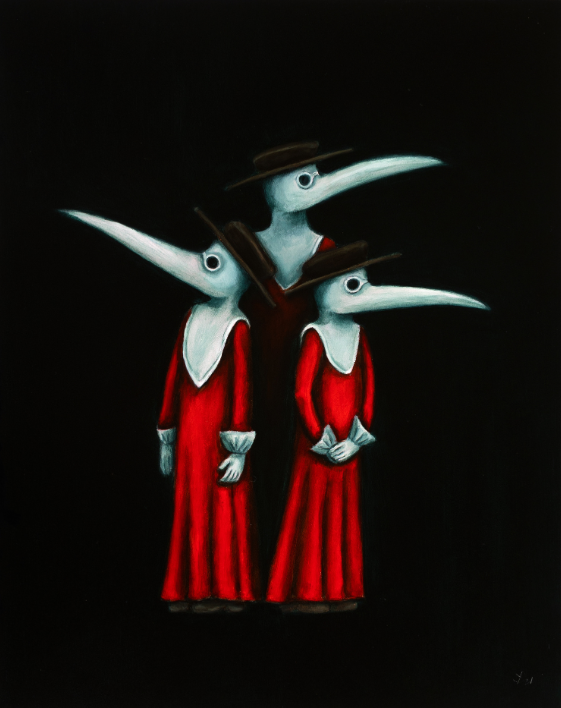
Maria Pia Mosquera
Hello Dear Maria Pia Mosquera. Thank you for giving us the chance to Interview with you. Our first question is how the “Covid-19” affects your art?
Hi and thank you for having me! Oh well, this pandemic has had multiple effects on my art. Since Covid-19 came into our lives and the lockdowns started, we had to reassess our social interactions, our relationship with illness and health, time and all those simple pleasures that we took for granted.
Firstly, for me, Covid meant that lots of my work as an exhibition designer was postponed or cancelled. This created a vacuum for my creative energy and it took me a couple of weeks to re-channel this creativity. The news we saw from around the world were so devastating, and the sadness that lingered made think deeper about mortality and death. My family is in Colombia, I’m in Australia, and I couldn’t be with them. I felt very low. I started seeking refuge from the news in my imagination and started contemplating how to turn all this darkness around. So, fortunately for me I was able to put to pen to paper, or brush to board, and consolidate The Penitents series.
Can you tell us a little bit about yourself and what drove you to choose art as a career?
I was born in Bogotá, Colombia. Because of my dad’s work I got to live in different countries, my last stop was Australia 24 years ago. Art has always been an integral part of my life. My mother is a painter and since I was a little girl, I used to love drawing portraits of our pets and later of our family members. Sometimes I would write poems and add landscapes to them, I made my own illustrated books.
As a career it took time. The love and desire were always there, but at home my parents didn’t see it at first as a professional option. So, from Law, then Ecology until I got to Graphic Design, which I studied with a major in illustration. From there things started to take off. I have studied in multiple art schools in Colombia and Australia, developing my technique and my visual language.
Is the artistic life lonely? What do you do to counteract it?
It can be, but it’s that time with your thoughts that is crucial for invention. I run my own graphic design consultancy, so I do spend a lot of time on my own. I found that the best way for me to navigate my days is in sections and tasks. If I know what I have to do, there’s not much time to feel lonely or lost, it’s straight to work, no time to waste.
I’m a gregarious person, an extrovert even, so I try to catch up with friends and family regularly. I love music, seeing bands is one of my greatest pleasures. Plus, the daily social interactions are what I find interesting and fuel parts of my work. Back at home, I make sure I have plenty of family time, cuddles with my husband, son and cat. Sometimes they tell me I talk too much; I think they forget that probably that day I haven’t spoken to anyone else.
Can’t wait for the lockdowns to be over so I get to see people in the flesh again!
Can you describe a real-life situation that inspired you as an Artist?
Everyday life inspires me, even the most mundane actions inspire me. Going to the supermarket, catching the bus. I’m always looking and taking these mental pictures. Maybe because I’m always thinking how that would translate into the stories, how would that action be if the people catching the bus are devils and demons, for example. I’m hopeful that my audience can see themselves reflected in the imagery, that moment when you say: “That has happened to me!”
We want to talk about the Fantastic creatures in your Artworks. Can you tell us more about your theme and how do you choose the subject of your painting?
Since I started making art I realised that the surreal and the absurd attracted me more than hyperrealism and still lives. Story telling is important for me too. So these fantastic creatures are companions, messengers and actors for my crazy ideas. I can make them do whatever I want.
A theme that’s constantly present in my work is death, the objective of my current work is to challenge this preconception of death as something macabre. Death is the only thing certain in this life, so putting it in a scary light makes no sense. We can lose fear of something by making it friendly, humorous. The skull (calavera) for example, why fear it? We all have one, underneath our flesh, and it will remain as the eternal smile at the end of our lives. By finding the humour in it I hope to shift this relationship.
Death is certain, laugh at it!
Can you explain to us and our readers to “The Penitents" Collection of yours?
The Penitents are a dream, a place where the boundary between life and death is blurred. In this place, these hooded characters find themselves coexisting with their tormentors, these devils that torture them, this death that haunts them. And the reality is that they have lived with them for so long, that they don’t remember anymore how they got there, or why they are there. They just live with them, under cloak and robe and the weight of their sins, waiting for the eternal smile.
In the series, that’s over 30 paintings, and also includes a wallpaper and felt toys, I wanted to show as much as possible of their everyday lives. How they interact with these creatures, how they fill their days, how they learned to coexist. My wish was for the audience to have a giggle and see themselves represented in the characters.
The Penitents are deeply rooted to my Latin-American heritage. I see them as celebration of my culture. Growing up in Latin-America, surrounded by so much history, symbolism and faith, all these elements are part of my tradition and are part of my folklore. Something very strong in Latin America is the presence of religious colonial art. In Bogotá for example, it’s present not only in churches and museums, but in people’s homes. Religious art is part of the everyday. In the paintings there’s also present pagan symbolism.
The Penitents borrow the look directly from the Nazarene penitents, they are Catholic religious groups that dress up with the capirotes (pointy hoods) during the processions at Easter. They are present around Latin areas of Europe and Latin-America. And no, they are not KKK — how the KKK took their outfits from them is another story.
Anything else you'd like to mention that I didn't ask?
Something I get asked regularly is that if I’m religious. The answer is no.
I was born and raised Catholic, but for a long time now I don’t practise any religion. My relationship with the church as an institution is very different to my relationship with religious symbolism and elements that are part of my culture.
And I guess, what I’m working on now? Currently I’m embarking on the research for a new series, I can tell you there will be more fantastical and crazier creatures, and it will dwell in the lives of the messengers of the underworld, prepare to be tempted.
And thank you for having me! xxx
www.maria-pia-mosquera.com
www.instagram.com/mariapiamosquera
